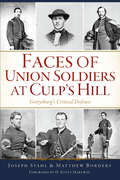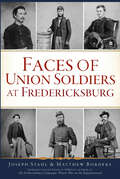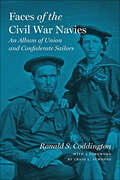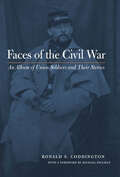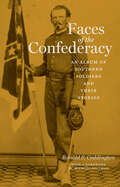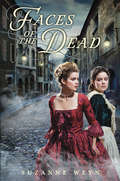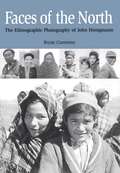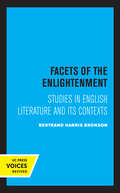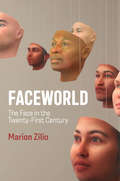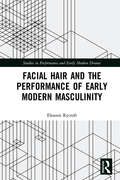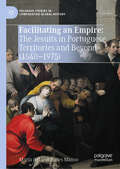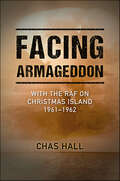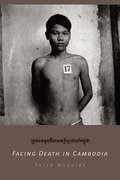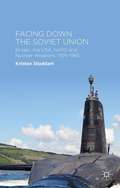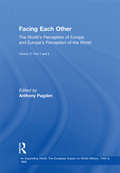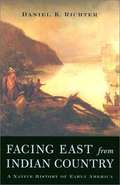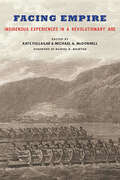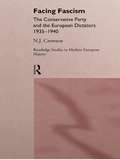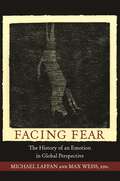- Table View
- List View
Faces of Union Soldiers at Culp's Hill: Gettysburg's Critical Defense (Civil War Series)
by Joseph Stahl Matthew BordersThe most pivotal deffensive line in the most pivotal battle in the history of America. The fighting at Culp's Hill during the Battle of Gettysburg was some of the fiercest during the bloody battle, and holding the hill, for the Union, was essential not only for victory in battle, but protecting the country as a whole. Authors Matthew Borders and Joseph Stahl present intimate portraits of twenty-eight soldiers who defended Culp's Hill, including in-depth analysis of never before published images and harrowing accounts of heroism in the fight to save the Union.
Faces of Union Soldiers at Fredericksburg (Civil War Series)
by Matthew BordersLook into the eyes of these soldiers and see the faces of those who dared to stare into the face of Death.The Battle of Fredericksburg, fought December 11-15, 1862, is often remembered for the seemingly futile attacks by the Army of the Potomac against dug in Confederates on Marye's Heights. Less well understood is the fighting south of the heights on what has become known as Slaughter Pen Farm. In this work the images of thirty Union soldiers are published for the first time. They give a face and history to those men who struggled across that bloody landscape, as well as to those that charged up the slope of Marye's Heights into Confederate fire. Authors Matthew Borders and Joseph Stahl introduce you to these men, their stories and their sacrifice on the bullet swept battlefield of Fredericksburg.
Faces of the Civil War Navies: An Album of Human and Confederate Sailors
by Ronald S. CoddingtonExplore the human side of the Civil War through archival images and biographical sketches of Confederate and Union sailors.During the American Civil War, more than one hundred thousand men fought on ships at sea or on one of America’s great inland rivers. There were no large-scale fleet engagements, yet the navies, particularly the Union Navy, did much to define the character of the war and affect its length. The first hostile shots roared from rebel artillery at Charleston Harbor. Along the Mississippi River and other inland waterways across the South, Union gunboats were often the first to arrive in deadly enemy territory. In the Gulf of Mexico and along the Atlantic seaboard, blockaders in blue floated within earshot of gray garrisons that guarded vital ports. And on the open seas, rebel raiders wreaked havoc on civilian shipping.In Faces of the Civil War Navies, Civil War photograph collector Ronald S. Coddington focuses his skills on the Union and Confederate navies. Using identifiable cartes de visite of common sailors on both sides of the war, many of them never before published, Coddington uncovers the personal histories of each individual. These unique narratives are drawn from military and pension records, letters, diaries, period newspapers, and other primary sources. In addition to presenting the personal stories of seventy-seven intrepid volunteers, Coddington also focuses on the momentous naval events that ushered in an era of ironclad ships and other technical innovations.Taken collectively, these “snapshots” show that the history of war is not merely a chronicle of campaigns won and lost, it is the collective personal odysseys of thousands of individual men.
Faces of the Civil War Navies: An Album of Union and Confederate Sailors
by Ronald S. CoddingtonArchival images and biographical sketches of common sailors on both sides of the conflict reveal the human side of the Civil War.During the American Civil War, more than one hundred thousand men fought on ships at sea or on one of America’s great inland rivers. There were no large-scale fleet engagements, yet the navies, particularly the Union Navy, did much to define the character of the war and affect its length. The first hostile shots roared from rebel artillery at Charleston Harbor. Along the Mississippi River and other inland waterways across the South, Union gunboats were often the first to arrive in deadly enemy territory. In the Gulf of Mexico and along the Atlantic seaboard, blockaders in blue floated within earshot of gray garrisons that guarded vital ports. And on the open seas, rebel raiders wreaked havoc on civilian shipping. In Faces of the Civil War Navies, renowned researcher and Civil War photograph collector Ronald S. Coddington focuses his considerable skills on the Union and Confederate navies. Using identifiable cartes de visite of common sailors on both sides of the war, many of them never before published, Coddington uncovers the personal histories of each individual who looked into the eye of the primitive camera. These unique narratives are drawn from military and pension records, letters, diaries, period newspapers, and other primary sources. In addition to presenting the personal stories of seventy-seven intrepid volunteers, Coddington also focuses on the momentous naval events that ushered in an era of ironclad ships and other technical innovations. The fourth volume in Coddington’s series on Civil War soldiers, this microhistory will appeal to anyone with an interest in the Civil War, social history, or photography. The narratives and photographs in Faces of the Civil War Navies shed new light on a lesser-known part of our American story. Taken collectively, these "snapshots" remind us that the history of war is not merely a chronicle of campaigns won and lost, it is the collective personal odysseys of thousands of individual life stories.
Faces of the Civil War: An Album of Union Soldiers and Their Stories
by Ronald S CoddingtonArchival images and biographical sketches of Union soldiers tell the stories of their lives during and after the Civil War.Before leaving to fight in the Civil War, many Union and Confederate soldiers posed for a carte de visite, or visiting card, to give to their families, friends, or sweethearts. Invented in 1854 by a French photographer, the carte de visite was a small photographic print roughly the size of a modern trading card. The format arrived in America on the eve of the Civil War, fueling intense demand for the keepsakes. Many cards of Civil War soldiers survive today, but the experiences?and often the names?of the individuals portrayed have been lost to time. A passionate collector of Civil War–era photography, Ron Coddington researched the history behind these anonymous faces in military records, pension files, and other public and personal documents.In Faces of the Civil War, Coddington presents 77 cartes de visite of Union soldiers from his collection and tells the stories of their lives during and after the war. These soldiers came from all walks of life. All were volunteers. Their personal stories reveal a tremendous diversity in their experience of war: many served with distinction, some were captured, some never saw combat while others saw little else. The lives of survivors were even more disparate. While some made successful transitions back to civilian life, others suffered permanent physical and mental disabilities, which too often wrecked their families and careers. In compelling words and haunting pictures, Faces of the Civil War offers a unique perspective on the most dramatic and wrenching period in American history.
Faces of the Civil War: An Album of Union Soldiers and Their Stories
by Ronald S. CoddingtonArchival images and biographical sketches of Union soldiers tell the stories of their lives during and after the Civil War.Before going off to fight in the Civil War, many soldiers on both sides of the conflict posed for a carte de visite, or visiting card, to give to their families, friends, or sweethearts. Invented in 1854 by a French photographer, the carte de visite was a small photographic print roughly the size of a modern trading card. The format arrived in America on the eve of the Civil War, which fueled intense demand for the convenient and affordable keepsakes. Considerable numbers of these portrait cards of Civil War soldiers survive today, but the experiences—and often the names—of the individuals portrayed have been lost to time. A passionate collector of Civil War–era photography, Ron Coddington became intrigued by these anonymous faces and began to research the history behind them in military records, pension files, and other public and personal documents.In Faces of the Civil War, Coddington presents 77 cartes de visite of Union soldiers from his collection and tells the stories of their lives during and after the war. The soldiers portrayed were wealthy and poor, educated and unschooled, native-born and immigrant, urban and rural. All were volunteers. Their personal stories reveal a tremendous diversity in their experience of war: many served with distinction, some were captured, some never saw combat while others saw little else. The lives of those who survived the war were even more disparate. While some made successful transitions back to civilian life, others suffered permanent physical and mental disabilities, which too often wrecked their families and careers. In compelling words and haunting pictures, Faces of the Civil War offers a unique perspective on the most dramatic and wrenching period in American history.
Faces of the Confederacy: An Album of Southern Soldiers and Their Stories
by Ronald S. Coddington"The history of the Civil War is the stories of its soldiers," writes Ronald S. Coddington in the preface to Faces of the Confederacy. This book tells the stories of seventy-seven Southern soldiers—young farm boys, wealthy plantation owners, intellectual elites, uneducated poor—who posed for photographic portraits, cartes de visite, to leave with family, friends, and sweethearts before going off to war. Coddington, a passionate collector of Civil War–era photography, conducted a monumental search for these previously unpublished portrait cards, then unearthed the personal stories of their subjects, putting a human face on a war rife with inhuman atrocities. The Civil War took the lives of 22 of every 100 men who served. Coddington follows the exhausted survivors as they return home to occupied cities and towns, ravaged farmlands, a destabilized economy, and a social order in the midst of upheaval. This book is a haunting and moving tribute to those brave men. Like its companion volume, Faces of the Civil War: An Album of Union Soldiers and Their Stories, this book offers readers a unique perspective on the war and contributes to a better understanding of the role of the common soldier.
Faces of the Confederacy: An Album of Southern Soldiers and Their Stories
by Ronald S. Coddington“Extensive research, fascinating characters . . . The author has done an admirable job of literally placing a face on the ordinary Confederate soldier.” —The Journal of Southern History“The history of the Civil War is the stories of its soldiers,” writes Ronald S. Coddington in the preface to Faces of the Confederacy. This book tells the stories of seventy-seven Southern soldiers—young farm boys, wealthy plantation owners, intellectual elites, uneducated poor—who posed for photographic portraits, cartes de visite, to leave with family, friends, and sweethearts before going off to war. Coddington, a passionate collector of Civil War-era photography, conducted a monumental search for these previously unpublished portrait cards, then unearthed the personal stories of their subjects, putting a human face on a war rife with inhuman atrocities.The Civil War took the lives of twenty-two of every hundred men who served. Coddington follows the exhausted survivors as they return home to occupied cities and towns, ravaged farmlands, a destabilized economy, and a social order in the midst of upheaval. This book is a haunting and moving tribute to those brave men.Like its companion volume, Faces of the Civil War: An Album of Union Soldiers and Their Stories, this book offers readers a unique perspective on the war and contributes to a better understanding of the role of the common soldier.“With his meticulous research and a journalist’s eye for good stories, Ron Coddington has brought new life to Civil War photographic portraits of obscure and long-forgotten Confederates whose wartime experiences might otherwise have been lost to history.” —Bob Zeller, cofounder and president of the nonprofit Center for Civil War Photography
Faces of the Dead
by Suzanne WeynWhen Marie-Therese, daughter of Marie Antoinette, slips into the streets of Paris at the height of the French Revolution, she finds a world much darker than what she's ever known. When Marie-Thérèse Charlotte of France learns of the powerful rebellion sweeping her country, the sheltered princess is determined to see the revolution for herself. Switching places with a chambermaid, the princess sneaks out of the safety of the royal palace and into the heart of a city in strife. Soon the princess is brushing shoulders with revolutionaries and activists. One boy in particular, Henri, befriends her and has her questioning the only life she's known. When the princess returns to the palace one night to find an angry mob storming its walls, she's forced into hiding in Paris. Henri brings her to the workshop of one Mademoiselle Grosholtz, whose wax figures seem to bring the famous back from the dead, and who looks at Marie-Thérèse as if she can see all of her secrets. There, the princess quickly discovers there's much more to the outside world - and to the mysterious woman's wax figures - than meets the eye.
Faces of the North: The Ethnographic Photography of John Honigmann
by Bryan CumminsJohn J. Honigmann was an anthropologist of rare energy and talent. In addition to writing numerous books and dozens of articles, he is the only anthropologist whose research and field experience extend across the three northern culture areas of Canada – the Western Subarctic, the Eastern Subarctic and the Arctic. Faces of the North presents a record of exceptionally high quality photographs depicting this extraordinary anthropological journey. Cultural anthropologist Bryan Cummins has compiled a written and photographic account of Honigmann’s ethnographic work from the 1940s to the 1960s. The result is a stunning ethnohistorical account of Canada’s First Nations in the mid-20th century. The author also provides an overview of northern First Nations (Algonkians, Dene and Inuit), a history of Canadian anthropology and the sub-discipline of ethnographic photography, and a biographical account of Dr. J.J. Honigmann, the acknowledged pre-eminent chronicler of the cultural diversity of Canada’s north. His superb photographs, many of which are found throughout Faces of the North, are a rich treasure of ethnographic images depicting Inuit and First Nations culture.
Facets of the Enlightenment: Studies in English Literature and Its Contexts
by Bertrand H. BronsonThis title is part of UC Press's Voices Revived program, which commemorates University of California Press’s mission to seek out and cultivate the brightest minds and give them voice, reach, and impact. Drawing on a backlist dating to 1893, Voices Revived makes high-quality, peer-reviewed scholarship accessible once again using print-on-demand technology. This title was originally published in 1968.
Faceworld
by Marion ZilioWe have long accepted the face as the most natural and self-evident thing, believing that in it we could read, as if on a screen, our emotions and our doubts, our anger and joy. We have decorated them, made them up, designed them, as if the face were the true calling card of our personality, the public manifestation of our inner being. Nothing could be further from the truth. Rather than a window opening onto our inner nature, the face has always been a technical artefact—a construction that owes as much to artificiality as to our genetic inheritance. From the origins of humanity to the triumph of the selfie, Marion Zilio charts the history of the technical, economic, political, legal, and artistic fabrication of the face. Her account of this history culminates in a radical new interrogation of what is too often denounced as our contemporary narcissism. In fact, argues Zilio, the “narcissism” of the selfie may well reconnect us to the deepest sources of the human manufacture of faces—a reconnection that would also be a chance for us to come to terms with the non-human part of ourselves. This highly original reflection on the fabrication of the face will be of great value to students and scholars of media and culture and to anyone interested in the pervasiveness of the face in our contemporary age of the selfie.
Facial Hair and the Performance of Early Modern Masculinity (Studies in Performance and Early Modern Drama)
by Eleanor RycroftFacial Hair and the Performance of Early Modern Masculinity is the first full-length critical study to analyse the importance of beards in terms of the theatrical performance of masculinity. According to medical, cultural, and literary discourses of early modern era in England, facial hair marked adult manliness while beardlessness indicated boyhood. Beards were therefore a passport to cultural prerogatives. This book explores this in relation to the early modern stage, a space in which the processes of gender formation in early modern society were writ large, and how the uses of facial hair in the theatre illuminate the operations of power and politics in society more widely. Written for scholars of Early Modern Theatre and Theatre History, this volume anatomises the role of beards in the construction of onstage masculinity, acknowledging the challenges offered to the dominant ideology of manliness by boys and men who misrepresented or failed to fulfil bearded masculine ideals.
Facilitating an Empire: The Jesuits in Portuguese Territories and Beyond (Palgrave Studies in Comparative Global History)
by Maria de Deus Beites MansoThis book explores the Jesuit order of its origins, historical evolution, missionary endeavors, and global dynamics, with a specific focus on Portugal and the challenges arising from changes in the former Portuguese Empire. The narrative unfolds in three parts, with the initial section exploring the foundation of the Jesuit order in 1540, approved by Pope Paul III. Examining the order's presence in Portugal, its connections with the Portuguese monarchy, and its educational initiatives, the exploration extends to a global Christianization mission aligned with crown and Roman interests. The second part shifts focus to Jesuit provinces beyond Europe, exploring regions with limited European presence through missionary action. Using a comparative and connected historical approach, the study analyzes missionary geography, identifying parallels and differences shaped by a "collective" dynamic involving the Society of Jesus, the crown, Rome, and diverse geographical dimensions. The third segment addresses the restoration of the Society of Jesus, particularly in Portugal, navigating global dynamics. The evolving landscape of the former Portuguese Empire necessitates a new contextualization, signifying the need for currently unfeasible investigations. The book will appeal for an academic audience with a specific interest in the detailed examination of the Jesuit order's history, its organizational structure, and its impact on missionary activities, both within Portugal and in regions with limited European presence.
Facing Armageddon: With the RAF on Christmas Island 1961–1962
by Chas Hall"...a worthy addition to a little-known aspect of British military history." — Flypast After being called up for National Service in July 1960, twenty-year-old Chas Hall joined the RAF and signed on to extend his time for an extra three years becoming a regular serviceman. Following initial training, he became a wireless operator and served at RAF Mildenhall. It was shortly after this that he got his first foreign posting in late 1961 to Christmas Island. It was on this island, that Chas encountered the horrors of nuclear testing. In an operation codenamed ‘Brigadoon’ by the British government and ‘Dominic’ by the Americans, Chas experienced 25 atmospheric nuclear tests. This he describes as his ‘12-month sentence’ alongside over 300 British and 10,000 American servicemen who were posted to one corner of a remote coral island. Facing Armageddon reveals the true extent of the controversial nuclear testing and how it affected servicemen; with 25 men dying during Chas’s time on Christmas Island and many more suffering mentally as they continued serving on the island. With the British government announcing medals for nuclear test veterans in November 2022 to recognize their contribution in the tests after a four-year campaign by participants and The Mirror newspaper, Chas’s story gives insight to why these servicemen deserve the recognition for their part in these tests. This book will contain a number of unpublished photos from the author’s personal collection and is an essential piece of work in understanding the tough conditions servicemen faced during their time on Christmas Island.
Facing Death in Cambodia
by Peter MaguireThis book is the story of Peter Maguire's effort to learn how Cambodia's "culture of impunity" developed, why it persists, and the failures of the "international community" to confront the Cambodian genocide. Written from a personal and historical perspective, Facing Death in Cambodia recounts Maguire's growing anguish over the gap between theories of universal justice and political realities. Maguire documents the atrocities and the aftermath through personal interviews with victims and perpetrators, discussions with international officials, journalistic accounts, and government sources.
Facing Death in Cambodia
by Peter MaguireThe Khmer Rouge regime took control of Cambodia by force of arms, then committed the most brazen crimes since the Third Reich: at least 1.5 million people murdered between 1975 and 1979. Yet no individuals were ever tried or punished. This book is the story of Peter Maguire's effort to learn how Cambodia's "culture of impunity" developed, why it persists, and the failures of the "international community" to confront the Cambodian genocide. Written from a personal and historical perspective, Facing Death in Cambodia recounts Maguire's growing anguish over the gap between theories of universal justice and political realities.Maguire documents the atrocities and the aftermath through personal interviews with victims and perpetrators, discussions with international and NGO officials, journalistic accounts, and government sources gathered during a ten-year odyssey in search of answers. The book includes a selection of haunting pictures from among the thousands taken at the now infamous Tuol Sleng prison (also referred to as S-21), through which at least 14,000 men, women, and children passed—and from which fewer than a dozen emerged alive.What he discovered raises troubling questions: Was the Cambodian genocide a preview of the genocidal civil wars that would follow in the wake of the Cold War? Is international justice an attainable idea or a fiction superimposed over an unbearably dark reality? Did issues of political expediency allow Cambodian leaders to escape prosecution?The Khmer Rouge violated the Nuremberg Principles, the United Nations Charter, the laws of war, and the UN Genocide Convention. Yet in the decade after the regime's collapse, the perpetrators were rescued and rehabilitated-even rewarded-by China, Thailand, the United States, and the UN. According to Peter Maguire, Cambodia holds the key to understanding why recent UN interventions throughout the world have failed to prevent atrocities and to enforce treaties.
Facing Down The Soviet Union: Britain, The Usa, Nato And Nuclear Weapons, 1976-1983
by Kristan StoddartFacing Each Other: The World’s Perception of Europe and Europe’s Perception of the World (An Expanding World: The European Impact on World History, 1450 to 1800 #31)
by Anthony PagdenThe perception of Europeans of the world and of the peoples beyond Europe has become in recent years the subject of intense scholarly interest and heated debate both in and outside the academy. So, too, has the concern with how it was that those peoples who were variously ’discovered’, and then, as often as not, colonised, understood the strangers in their midst. This volume attempts to cover both these topics, as well as to provide a number of crucial articles on the difficulties faced by modern historians in understanding the complex, relationship between ’them’ and ’us’. Inevitably such relationships not only changed over time, they also varied greatly from culture to culture. The articles, therefore cover most of the areas with which the European world came into contact from the earliest Portuguese incursions into Africa in the mid fifteenth century until the explorations of Cook and Bougainville in the Pacific in the late eighteenth. It ranges, too, from Brazil to Russia, from Tahiti to China.
Facing East from Indian Country: A Native History of Early America
by Daniel K. RichterIn the beginning, North America was Indian country. But only in the beginning. After the opening act of the great national drama, Native Americans yielded to the westward rush of European settlers. Or so the story usually goes. Yet, for three centuries after Columbus, Native people controlled most of eastern North America and profoundly shaped its destiny. In Facing East from Indian Country, Daniel K. Richter keeps Native people center-stage throughout the story of the origins of the United States. Viewed from Indian country, the sixteenth century was an era in which Native people discovered Europeans and struggled to make sense of a new world. Well into the seventeenth century, the most profound challenges to Indian life came less from the arrival of a relative handful of European colonists than from the biological, economic, and environmental forces the newcomers unleashed. Drawing upon their own traditions, Indian communities reinvented themselves and carved out a place in a world dominated by transatlantic European empires. In 1776, however, when some of Britain's colonists rebelled against that imperial world, they overturned the system that had made Euro-American and Native coexistence possible. Eastern North America only ceased to be an Indian country because the revolutionaries denied the continent's first peoples a place in the nation they were creating. In rediscovering early America as Indian country, Richter employs the historian's craft to challenge cherished assumptions about times and places we thought we knew well, revealing Native American experiences at the core of the nation's birth and identity.
Facing Empire: Indigenous Experiences in a Revolutionary Age
by Kate Fullagar and Michael A. McDonnellA comprehensive volume that interrogates European imperialism from the perspective of indigenous experiences.The contributors to Facing Empire reimagine the Age of Revolution from the perspective of indigenous peoples. Rather than treating indigenous peoples as distant and passive players in the political struggles of the time, this book argues that they helped create and exploit the volatility that marked an era while playing a central role in the profound acceleration in encounters and contacts between peoples around the world. Focusing in particular on indigenous peoples’ experiences of the British Empire, this volume takes a unique comparative approach in thinking about how indigenous peoples shaped, influenced, redirected, ignored, and sometimes even forced the course of modern imperialism. The essays demonstrate how indigenous-shaped local exchanges, cultural relations, and warfare provoked discussion and policymaking in London as much as it did in Charleston, Cape Town, or Sydney. Facing Empire charts a fresh way forward for historians of empire, indigenous studies, and the Age of Revolution and shows why scholars can no longer continue to exclude indigenous peoples from histories of the modern world. These past conflicts over land and water, labor and resources, and hearts and minds have left a living legacy of contested relations that continue to resonate in contemporary politics and societies today. Covering the Indian and Pacific Oceans, Australia, and West and South Africa, as well as North America, this book looks at the often misrepresented and underrepresented complexity of the indigenous experience on a global scale.Contributors: Tony Ballantyne, Justin Brooks, Colin G. Calloway, Kate Fullagar, Bill Gammage, Robert Kenny, Shino Konishi, Elspeth Martini, Michael A. McDonnell, Jennifer Newell, Joshua L. Reid, Daniel K. Richter, Rebecca Shumway, Sujit Sivasundaram, Nicole Ulrich
Facing Empire: Indigenous Experiences in a Revolutionary Age
by Kate Fullagar and Michael A. McDonnellA major reframing of world history, this anthology interrogates eighteenth- and nineteenth-century European imperialism from the perspective of indigenous peoples.Rather than casting indigenous peoples as bystanders in the Age of Revolution, Facing Empire examines the active roles they played in helping to shape the course of modern imperialism. Focusing on indigenous peoples’ experiences of the British Empire, the volume’s comparative approach highlights the commonalities of indigenous struggles and strategies across the globe.Facing Empire charts a fresh way forward for historians of empire, indigenous studies, and the Age of Revolution. Covering the Indian and Pacific Oceans, Australia, and West and South Africa, as well as North America, this book looks at the often misrepresented and underrepresented complexity of the indigenous experience on a global scale.Contributors: Tony Ballantyne, Justin Brooks, Colin G. Calloway, Kate Fullagar, Bill Gammage, Robert Kenny, Shino Konishi, Elspeth Martini, Michael A. McDonnell, Jennifer Newell, Joshua L. Reid, Daniel K. Richter, Rebecca Shumway, Sujit Sivasundaram, Nicole Ulrich
Facing Eugenics
by Erika DyckFacing Eugenics is a social history of sexual sterilization operations in twentieth-century Canada. Looking at real-life experiences of men and women who, either coercively or voluntarily, participated in the largest legal eugenics program in Canada, it considers the impact of successive legal policies and medical practices on shaping our understanding of contemporary reproductive rights. The book also provides deep insights into the broader implications of medical experimentation, institutionalization, and health care in North America.Erika Dyck uses a range of historical evidence, including medical files, court testimony, and personal records to place mental health and intelligence at the centre of discussions regarding reproductive fitness. Examining acts of resistance alongside heavy-handed decisions to sterilize people considered "unfit," Facing Eugenics illuminates how reproductive rights fit into a broader discussion of what constitutes civil liberties, modern feminism, and contemporary psychiatric survivor and disability activism.
Facing Fascism: The Conservative Party and The European Dictators 1935 -1940 (Routledge Studies in Modern European History)
by Nick CrowsonThis book examines the Conservative party's responses to the problems of fascism from 1935 - 1940. Crowson provides the historical context for the foreign policy of the period and examines the historiography of the Conservative party. He offers a new perspective on its policies and the reaction of its various elements to the deepening international crisis.
Facing Fear: The History of an Emotion in Global Perspective (Publications in Partnership with the Shelby Cullom Davis Center at Princeton University #4)
by Michael Laffan Max WeissFear is ubiquitous but slippery. It has been defined as a purely biological reality, derided as an excuse for cowardice, attacked as a force for social control, and even denigrated as an unnatural condition that has no place in the disenchanted world of enlightened modernity. In these times of institutionalized insecurity and global terror, Facing Fear sheds light on the meaning, diversity, and dynamism of fear in multiple world-historical contexts, and demonstrates how fear universally binds us to particular presents but also to a broad spectrum of memories, stories, and states in the past. From the eighteenth-century Peruvian highlands and the California borderlands to the urban cityscapes of contemporary Russia and India, this book collectively explores the wide range of causes, experiences, and explanations of this protean emotion. The volume contributes to the thriving literature on the history of emotions and destabilizes narratives that have often understood fear in very specific linguistic, cultural, and geographical settings. Rather, by using a comparative, multidisciplinary framework, the book situates fear in more global terms, breaks new ground in the historical and cultural analysis of emotions, and sets out a new agenda for further research. In addition to the editors, the contributors are Alexander Etkind, Lisbeth Haas, Andreas Killen, David Lederer, Melani McAlister, Ronald Schechter, Marla Stone, Ravi Sundaram, and Charles Walker.
